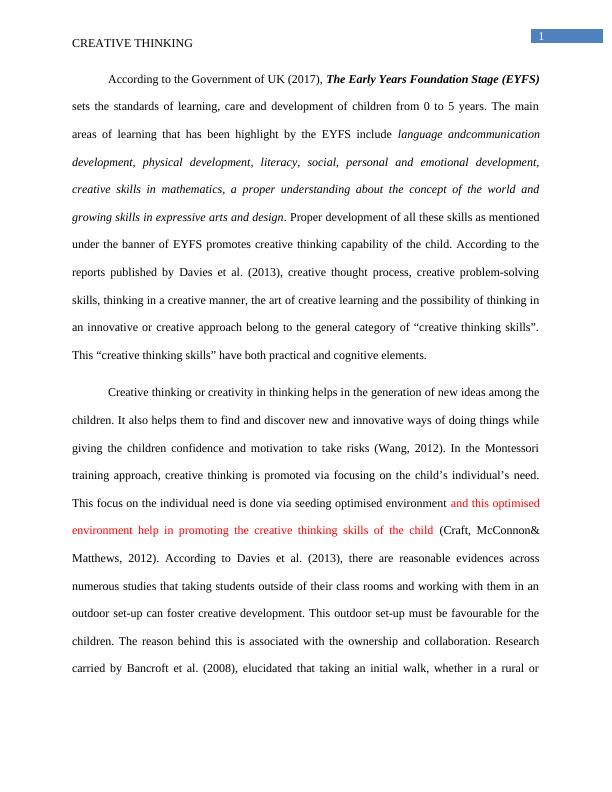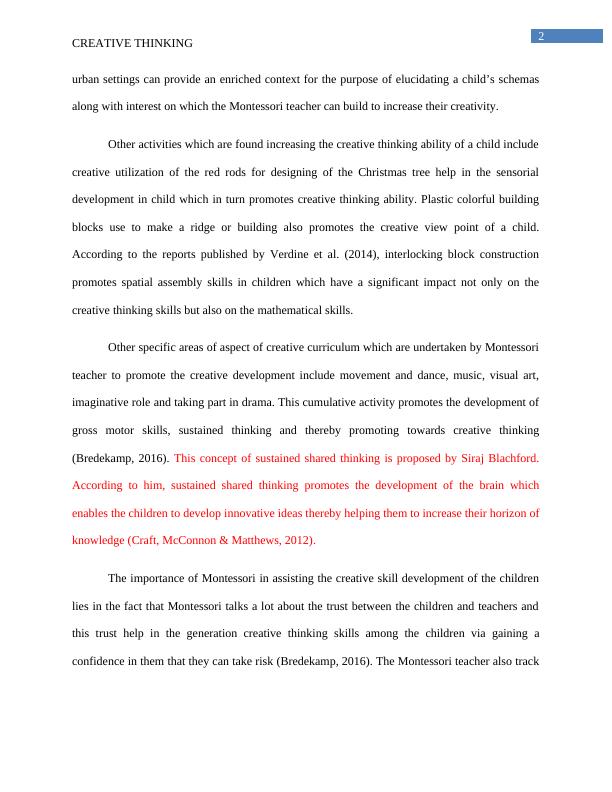Promoting Creative Thinking in Early Childhood Education
Added on 2023-06-15
7 Pages1442 Words437 Views
0Running head: CREATIVE THINKING
Creative Thinking
Name of the Student
Name of University
Author’s note
Creative Thinking
Name of the Student
Name of University
Author’s note

1
CREATIVE THINKING
According to the Government of UK (2017), The Early Years Foundation Stage (EYFS)
sets the standards of learning, care and development of children from 0 to 5 years. The main
areas of learning that has been highlight by the EYFS include language andcommunication
development, physical development, literacy, social, personal and emotional development,
creative skills in mathematics, a proper understanding about the concept of the world and
growing skills in expressive arts and design. Proper development of all these skills as mentioned
under the banner of EYFS promotes creative thinking capability of the child. According to the
reports published by Davies et al. (2013), creative thought process, creative problem-solving
skills, thinking in a creative manner, the art of creative learning and the possibility of thinking in
an innovative or creative approach belong to the general category of “creative thinking skills”.
This “creative thinking skills” have both practical and cognitive elements.
Creative thinking or creativity in thinking helps in the generation of new ideas among the
children. It also helps them to find and discover new and innovative ways of doing things while
giving the children confidence and motivation to take risks (Wang, 2012). In the Montessori
training approach, creative thinking is promoted via focusing on the child’s individual’s need.
This focus on the individual need is done via seeding optimised environment and this optimised
environment help in promoting the creative thinking skills of the child (Craft, McConnon&
Matthews, 2012). According to Davies et al. (2013), there are reasonable evidences across
numerous studies that taking students outside of their class rooms and working with them in an
outdoor set-up can foster creative development. This outdoor set-up must be favourable for the
children. The reason behind this is associated with the ownership and collaboration. Research
carried by Bancroft et al. (2008), elucidated that taking an initial walk, whether in a rural or
CREATIVE THINKING
According to the Government of UK (2017), The Early Years Foundation Stage (EYFS)
sets the standards of learning, care and development of children from 0 to 5 years. The main
areas of learning that has been highlight by the EYFS include language andcommunication
development, physical development, literacy, social, personal and emotional development,
creative skills in mathematics, a proper understanding about the concept of the world and
growing skills in expressive arts and design. Proper development of all these skills as mentioned
under the banner of EYFS promotes creative thinking capability of the child. According to the
reports published by Davies et al. (2013), creative thought process, creative problem-solving
skills, thinking in a creative manner, the art of creative learning and the possibility of thinking in
an innovative or creative approach belong to the general category of “creative thinking skills”.
This “creative thinking skills” have both practical and cognitive elements.
Creative thinking or creativity in thinking helps in the generation of new ideas among the
children. It also helps them to find and discover new and innovative ways of doing things while
giving the children confidence and motivation to take risks (Wang, 2012). In the Montessori
training approach, creative thinking is promoted via focusing on the child’s individual’s need.
This focus on the individual need is done via seeding optimised environment and this optimised
environment help in promoting the creative thinking skills of the child (Craft, McConnon&
Matthews, 2012). According to Davies et al. (2013), there are reasonable evidences across
numerous studies that taking students outside of their class rooms and working with them in an
outdoor set-up can foster creative development. This outdoor set-up must be favourable for the
children. The reason behind this is associated with the ownership and collaboration. Research
carried by Bancroft et al. (2008), elucidated that taking an initial walk, whether in a rural or

2
CREATIVE THINKING
urban settings can provide an enriched context for the purpose of elucidating a child’s schemas
along with interest on which the Montessori teacher can build to increase their creativity.
Other activities which are found increasing the creative thinking ability of a child include
creative utilization of the red rods for designing of the Christmas tree help in the sensorial
development in child which in turn promotes creative thinking ability. Plastic colorful building
blocks use to make a ridge or building also promotes the creative view point of a child.
According to the reports published by Verdine et al. (2014), interlocking block construction
promotes spatial assembly skills in children which have a significant impact not only on the
creative thinking skills but also on the mathematical skills.
Other specific areas of aspect of creative curriculum which are undertaken by Montessori
teacher to promote the creative development include movement and dance, music, visual art,
imaginative role and taking part in drama. This cumulative activity promotes the development of
gross motor skills, sustained thinking and thereby promoting towards creative thinking
(Bredekamp, 2016). This concept of sustained shared thinking is proposed by Siraj Blachford.
According to him, sustained shared thinking promotes the development of the brain which
enables the children to develop innovative ideas thereby helping them to increase their horizon of
knowledge (Craft, McConnon & Matthews, 2012).
The importance of Montessori in assisting the creative skill development of the children
lies in the fact that Montessori talks a lot about the trust between the children and teachers and
this trust help in the generation creative thinking skills among the children via gaining a
confidence in them that they can take risk (Bredekamp, 2016). The Montessori teacher also track
CREATIVE THINKING
urban settings can provide an enriched context for the purpose of elucidating a child’s schemas
along with interest on which the Montessori teacher can build to increase their creativity.
Other activities which are found increasing the creative thinking ability of a child include
creative utilization of the red rods for designing of the Christmas tree help in the sensorial
development in child which in turn promotes creative thinking ability. Plastic colorful building
blocks use to make a ridge or building also promotes the creative view point of a child.
According to the reports published by Verdine et al. (2014), interlocking block construction
promotes spatial assembly skills in children which have a significant impact not only on the
creative thinking skills but also on the mathematical skills.
Other specific areas of aspect of creative curriculum which are undertaken by Montessori
teacher to promote the creative development include movement and dance, music, visual art,
imaginative role and taking part in drama. This cumulative activity promotes the development of
gross motor skills, sustained thinking and thereby promoting towards creative thinking
(Bredekamp, 2016). This concept of sustained shared thinking is proposed by Siraj Blachford.
According to him, sustained shared thinking promotes the development of the brain which
enables the children to develop innovative ideas thereby helping them to increase their horizon of
knowledge (Craft, McConnon & Matthews, 2012).
The importance of Montessori in assisting the creative skill development of the children
lies in the fact that Montessori talks a lot about the trust between the children and teachers and
this trust help in the generation creative thinking skills among the children via gaining a
confidence in them that they can take risk (Bredekamp, 2016). The Montessori teacher also track

End of preview
Want to access all the pages? Upload your documents or become a member.
Related Documents
National Curriculum Analysis 2022lg...
|7
|3002
|33
Preparing Integrated Play Provocation and Learning Arealg...
|7
|1580
|301
Children's Learning Perspectiveslg...
|8
|2239
|91
Effect of Playing Building Blocks in Early Childhood Developmentlg...
|10
|2554
|20
A Toy for Playlg...
|5
|858
|209
Early Childhood Research Quarterlylg...
|4
|593
|16